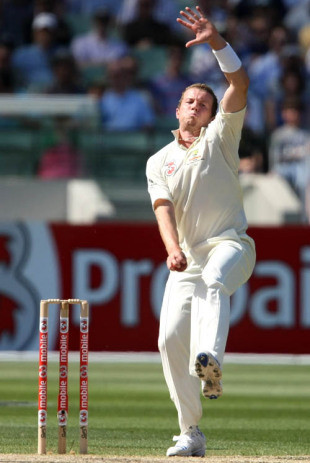|
|
|

Peter Siddle: "It [pitch] has deteriorated pretty quickly and the cracks have opened up a fair bit. It's going to get a little bit worse over the next couple of days"
© PA Photos
|
|
| |
Cracks have been forming all over the place during this series. For two
Tests the brittleness was Australia's, but in Sydney the fault lines have
been shaking South Africa. A fractured hand for the captain Graeme Smith
was followed by a broken helmet for Morne Morkel and a total of 327 on a
pitch that is breaking up ahead of schedule. Batting is not much fun and
will become more fraught over the next two days, with South Africa having
the tougher task after facing a deficit of 151 at stumps.
Two squiggly lines run up the length of the pitch, but the crack holding
the most danger sits just outside off stump for the right-handers batting
at the Paddington End and the lefties facing at the Randwick End. They
will continue to widen and smaller ones will appear, giving the bowlers
other targets to aim for. And when the ball is old and soft it often stays
lower on the flatter sections of the pitch, adding to the
unpredictability.
"It's up there with the top three toughest wickets I've ever had to bat
on, on day three," Mark Boucher said after registering a committed 89.
"It's not nice staring down the wicket and making sure you're running down
the side of it so you don't fall down."
The batsmen had to convince themselves to play forward and wait for the
ball to move in, out, down or up, depending on the angle of entry into the
gap. Finding rhythm was as impossible as feeling in control. South Africa
earned 202 runs on a day when the most courageous batting came from
Boucher and Morkel. South Africa were effectively 6 for 193 when they came
together - Smith won't bat - and they weathered and wore the Australian
attack for 115.
Ponting alternated the left-handers Johnson and Doug Bollinger at the
Paddington End for almost five hours. When those fast men were sprinting
in there was no respite for any of the batsmen. Australia were holding the
string as South Africa struggled and then scrapped through the
Boucher-Morkel recovery, but the advantage did not turn into easy wickets
until Siddle charged through late in the day to finish with 5 for 59.
Siddle, Andrew McDonald and Nathan Hauritz were used mostly at the
Randwick End, where there was less impact and only one wicket. When Siddle
was switched in the final session he captured 4 for 7 in 22 balls,
succeeding by aiming for the stumps instead of the gaps in the surface.
Morkel, Boucher and Dale Steyn were bowled and Paul Harris was lbw in the
sudden shift of tempo.
"Coming from that end, and being a right-hander, the crack wasn't on my
side," Siddle said. "I was just aiming for the stumps, getting a bit of
reverse-swing and trying to attack the stumps. I got a few uneven bounces,
some kept low, some got up, and kept the batter thinking."
Bollinger deserved to agree on at least one lbw with Billy Bowden and did
well to remain cool. His flustered reactions were limited to head shakes,
hands on hips and a few mutterings. Minor cracking, but no breaking.
Johnson accounted for Jacques Kallis and JP Duminy and all the quicks had
thick edges but not many slips.
The batsmen were most at ease when the ball left them off the marks, but
when it came back there was flinching and fending. A delivery from Johnson
re-directed off a crack for four wides down the legside and Boucher was
floored by one that appeared to brush his shoulder. Another from Bollinger
rose to dint Morkel's helmet.
On the second afternoon Johnson's crack-assisted off-cutter hit Smith's
left hand and sent him to hospital. He was in Melbourne having treatment
on his elbow while his team-mates jumped, hopped and hoped. Boucher tried
to play back as much as possible, looking awkward at times but in as much
comfort as any of the batsmen since Michael Clarke and Mitchell Johnson
the previous day. More grit will be required over the rest of the match
for anyone with a bat.
The pitch was in such a dry condition due to the groundsman Tom Parker
expecting showers in the lead-up to the game. He reduced the amount of
water he put on the surface, but the rain didn't come and there were lines
on it before the toss.
"It has deteriorated pretty quickly and the cracks have opened up a fair
bit," Siddle said. "It's going to get a little bit worse over the next
couple of days."
Batting will become even more treacherous during the second innings, but
it will be less of a bother for Ricky Ponting's order. Australia will need
to spend only a few hours on it on Tuesday before letting the under-manned
South Africa test their bravery again in their bid to save the game. There
will be no miracle chase in this match, but if the visitors hold on for a
draw it will improve their already high standing on this incredibly
successful tour.
Peter English is the Australasia editor of Cricinfo
